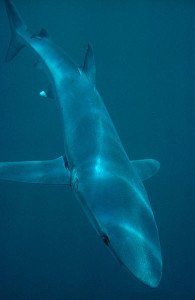Blue Shark Territory:
No Map Yet!
Blue Shark Basic Facts:
No Facts Yet!
Blue Shark Photos:
They are not as violent as other sharks in the ocean but they may attack if provoked or irritated. They can fight with larger prey. They are hunted mostly by humans for their fins, tails, and skin. They usually migrate from place to place. They are extremely fast and elegant swimmers. They swim long distances in search of food. Numerous attacks on people by blue sharks have been reported and they have caused great damage as they have very strong jaws and teeth.
Blue Sharks have weighted bodies with long fins. The top of their body is blue and the underside is white. They normally grow to a length of 13 feet and up to 450 pounds. They have several shades of blue color on their skin. Blue sharks are believed to live more than 20 years. The birth cycle lasts for 9 to 12 months. Females mature at 5 to 6 years and males mature at 4 to 5 years. Blue Sharks give birth to 5 to 125 pups. They are left by their mother to take care of themselves.
Facts About Blue Sharks
- Blue sharks have electroreceptors concentrated in their heads. They can sense a heartbeat of another fish from several miles away. The organ is called the “ampullae of Lorenzini.”
- They are among the few Viviparous sharks in the ocean. Females give birth to live pups.
- When mating, male sharks are very aggressive. They are seen biting the females but that is part of mating. The skin of female sharks is 3 times thicker than male skin.
- Blue Sharks survive poorly in captivity. Most of them survive for less than a month. Although the record of blue shark kept at captivity is 7 months.
- Blue Sharks are seen jumping out of the sea in search of their prey.
- As Blue Sharks are often seen in groups, and sometimes referred to the “wolves of the sea.”
- The main predators of blue sharks are humans. Approximately 15 to 20 million Blue Sharks are killed every year due to humans who capture them. They are hunted for their skin, fish oil, teeth and fins.
- Blue sharks are listed as “Near Threatened” in the Red list of IUCN.

